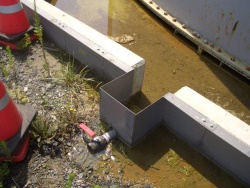Leak from Fukushima tank
20 August 2013
ORIGINALLY PUBLISHED: 12.46pm
UPDATE 1: 1.35pm: correct mistaken description of rainwater valve as faulty
UPDATE 2: 4.41pm: removal of soil and completion of pumping surface water
UPDATE 3: 5.54pm: clarification on radioactivity and treatment status
UPDATE 4: 21 August, 11.00am: potential reclassification on INES scale
CORRECTION: 5.58pm, 29 August: Faulty tank contained water with 200,000 Bq/L. Previous figure of 80 million Bq/L was measurement of leaked water accumulated within the dam.
Tepco is working to control a leak of radioactive water from a storage tank at Fukushima Daiichi. Water escaped from the tank and then reached the soil through a rainwater valve in the surrounding dam.
 |
| The rainwater valve, dam and tank |
The cooling of the reactor cores damaged in March 2011 still requires a constant flow of water, which circulates through the power plant basements. The water becomes radioactive after contact with the cores and is pumped to a storage and treatment facility before recirculation for cooling.
At about 9.50am yesterday, a worker on routine inspection found water leaking from a rainwater drain valve in a dam that surrounds a tank of partly treated contaminated water. This had formed two shallow puddles outside the dam. Investigations showed that the level of water in the tank was about 3 metres lower than expected, indicating that some 300 cubic metres had escaped.
Tepco told WNN that the leaked water had already passed through the first 'SARRY' stage of decontamination, which had removed most of the radioactive caesium. It was yet to pass through the 'ALPS' treatment that would remove strontium and other beta-emitting radionuclides.
Sampling on 26 August confirmed the beta radioactivity in the tank water to be 200,000 Bq/L compared to 80 million Bq/L measured in accumulated water within the dam, which had been subject to concentration through evaporation in hot weather. Dose rates measured for gamma and beta radiation were high at over 100 milliSieverts per hour near the leaked water within the dam, while the dose rate for gamma only was low at just 1.5 milliSieverts per hour. Tepco did not specify if these were dose rates at the water surface or, more likely, a standard 1 metre above the ground.
Clean-up
The drain valve has been successfully closed and water from the failed tank is currently being pumped to other tanks. Tepco is removing water from within the dam to a temporary tank with the intention to move it to other tanks at the facility.
Tepco has pumped away all the contaminated water that had accumulated on the surface and started removing affected soil from the area to storage, placing large sandbags in its place. The company's scientists are investigating how far the water may have spread and checking the area every three hours. It is also cleaning the floor slabs in the area.
There is no evidence that the water entered a drainage ditch, said Tepco, meaning it is unlikely to have left the area or reached the sea.
INES classification
The Japan Nuclear Regulation Authority (NRA) has preliminarily classified the incident at Level 1 on the International Nuclear Event Scale (INES) - an anomaly. However, based on an initial report submitted by Tepco, the regulator is considering raising this to Level 3 - a serious incident. The breakdown of a safety layer and the amount of radioactivity released by the leak meet some of the criteria of a Level 3 incident, it suggests. The NRA said that it will consult with the International Atomic Energy Agency about this reclassification.
The Japanese regulator also said that it was unsure whether the leak should be given its own INES rating or whether it should be treated as part of the overall Fukushima accident, already rated at Level 7 - a major accident.
Researched and written
by World Nuclear News